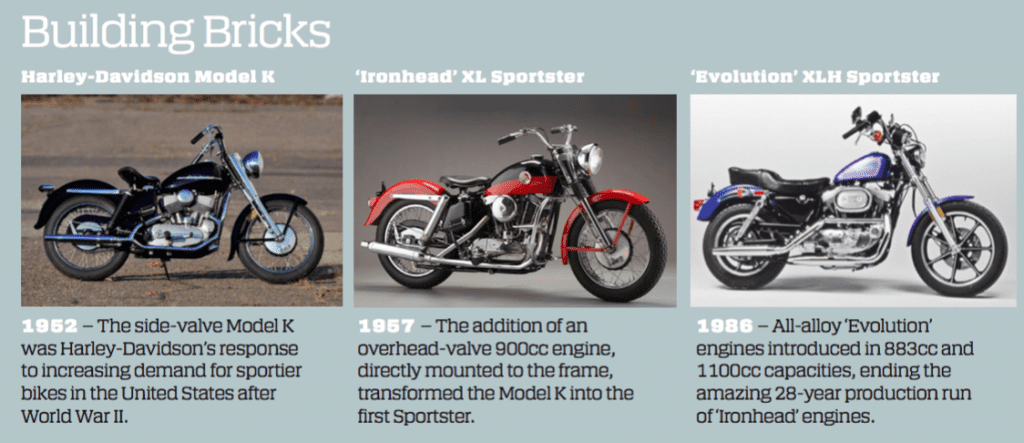Harley-Davidson caught many observers by surprise when it wheeled out the Sportster-based ‘old-school custom’, the Nightster, a decade or so back. It was followed in successive years by the flat-tracker tribute, the XR1200, the ‘dark custom’ Iron 883 and the ‘bar hopper’ Forty-Eight. Suddenly the bike that had long been disparaged as the ‘Skirtster’ by H-D
‘Big Twin’ enthusiasts was out of the shadows and proud.
Clearly lighter and more compact than their big brothers, the various members of the Sportster line-up lose out in terms of in-your-face presence to the big ’uns – but hey, they win it back in terms of agility and overall performance. And Sportster riders never doubt that they’re riding a Harley, thanks to the sound and feel of the traditional long-stroke 45º V-twin engines. That’s more than can be said of H-D’s Street 500 model – its short-stroke 60º motor just can’t manage a convincing Milwaukee accent.
Whether you go for a traditional Sportster or one of the recent factory customs mentioned above, you’re getting a competent motorcycle. Gutsy powertrain, robust chassis, reasonable handling, adequate braking – it’s all there.
The ‘little’ 883 motor does a nice job with an authentic Harley feel to it. The 1200 models are livelier, with heaps of torque and a decent power-to-weight ratio. Okay, they’re no sportsbikes, but a bit of Sportster play-racing with your mates through the hills will leave you grinning in a big way.
It’s worth remembering that Sportsters with very limited modifications put on some fabulous racetrack action back in the 1990s as the ‘Roaring Sporties’. A quick one could lap Phillip Island in under 1m50s. In support races at major meetings, they brought spectators rushing to the fences.
The observations in this review can be applied generally across all the five-speed, belt-drive models sold here between 1991 and 2013. The extensively revised 2014 and later models will be covered in a separate review.
The powerplants used throughout the period are the reliable all-alloy ‘Evolution’ engines (883 and 1200 versions).
The most significant changes along the way were the introduction in 2004 of rubber mountings for the engines (replacing the previous rigid-mount set-up), then fuel injection (replacing the CV carburettor) in 2007. From 2000, upgraded front brakes improved braking power.
Not surprisingly, the pre-2004 bikes with rigid-mounted engines feed a fair serve of vibration to the rider; it’s something many buyers will want to avoid by going for a
rubber-mount bike. On the other hand, some owners of the lighter rigid-mount models happily embrace engine vibration as a ‘character thing’, an essential part of the Harley experience.
The introduction of fuel injection in 2007 was a godsend for the 883 models in particular. The carby version of the smaller engine had been struggling in the face of emission-control modifications, which produced starting and warm-up issues. Replacing the carby with EFI transformed the 883 while also making the 1200 a happier engine.
Of course another tick in the Sportster box is that they’re quite affordable, especially by Harley-Davidson standards.
With myriad variations in styling and image between the various Sportsters, as well as differences in seat heights, fuel-tank capacities and wheel types and sizes, personal preference will determine which one to go for.
Overall, though, it’s fair to say that the later models are better motorcycles. And low kilometres and a good service record are always strong points in any bike’s favour.
Like all Harley-Davidsons, the Sportsters reach out to buyers through potent intangible factors such as looks, feel and image – and throw in a healthy dose of nostalgia for good measure. The Sportsters have all this in spades and they’re competent and reliable bikes to boot. What’s not to like?

WHAT TO LOOK FOR
Many early five-speed examples (1991-92) suffered transmission noise problems that were resolved in 1993 when gear profiles were subtly changed.
Later-model carburettor 883s can have cold-start and warm-up issues. Careful tuning can reduce the problems but they won’t go away entirely. EFI is a better choice.
As always, check the condition of steering-head bearings, tyres and brake pads, and for brake rotors that are close to minimum thickness. And don’t forget to check the drive-belt for damage.
SERVICE HISTORY
Sportsters are solid, reliable bikes that are very under-stressed in standard form.
Belt-drive eliminates chain maintenance worries and chain and sprocket replacement costs. The belts have a long life that’s only threatened by damage from stones and the like getting caught between belt and pulley.
The bike’s simple design and easy nakedbike access makes the Sportster an ideal bike for home mechanics, while also keeping professional servicing costs reasonable.
Minor services, including oil and filter changes, are required at 8000km intervals, while major services are due at 32,000km intervals.

New Price
$9495 (1991) – XL883
$11,995 (2013) – XL883N
Second-Hand
$3500 – $11,500











